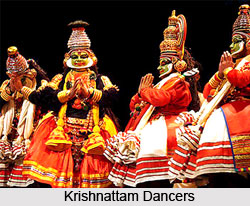 Rituals in Krishnattam start on the first day of the Krishnattam season. The senior opens the palm leaf manuscript of Krishnagiiti which is an entire series of plays being performed at the palace where the Zamorin was residing. Thereafter it is performed at Guruvaayur Krishna Temple and at other palaces according to the sponsors.
Rituals in Krishnattam start on the first day of the Krishnattam season. The senior opens the palm leaf manuscript of Krishnagiiti which is an entire series of plays being performed at the palace where the Zamorin was residing. Thereafter it is performed at Guruvaayur Krishna Temple and at other palaces according to the sponsors.
Just when the time appears for the performance, a Brahmin lights the oil lamp and the musicians come to the stage. Along `mundu` is worn with a shorter one that is tied over it. Only a cotton shawl is draped over the shoulders. The senior singers wear turbans that are given to them by the Zamorin in recognition of their talent and service in Krishnattam at temples.
All musicians stand horizontally before the lamp, pick up their instruments, touch them and then each of them touch their forehead. This is a symbol of respect for the sacred sounds that are produced by these instruments. The drum is held on one hand and single sounds are played on that end of the drum which faces stage and then the audience. Thereafter the gathered cloth is taken that is covered over the head. Each drummer hangs his drum around the waist and positions it comfortably over his stomach. A sequence is performed to inform the audience that the performance would begin now.
Thereafter stagehands hold up a curtain with concentric rectangular shape. Behind this curtain several dancers are standing dressed in female attire. They touch the floor which is a mark of respect to Goddess Earth. The singers begin their vocal performance. The pre performance song is followed by a poem which is recited in praise of Lord Vishnu as Guruvayurappan. Before starting each play songs are sung. The music of Krishnattam is sung in Sopana Sangeetham style. The four major talas of Krishnattam music are champa, champata, atanta and panchari.
A tirassiila or a curtain that is held by two persons is brought to the stage. Behind this there are four dancers in female attire who dance the totayam. Thereafter is the Purappadu, in which Krishna or Balarama comes from behind the curtain and perform their stage rituals. The story begins after these rituals are performed.
There is also a simple ritual that is associated with the wearing of a mudi or crown. Whoever places the headdress on the actor`s head (the chutti artist) first gives the actor some water. The actor puts this water on his eyes and feet which is symbolic of washing his face and feet and it is called tottu vandanam. Thereafter he touches the crown with both hands and touches both hands to his forehead which is called `talayil vacchu vandikkuka`. After this the actor chooses his weapon. Then he asks the permission of his teacher to enter the stage thereby requesting his teacher`s blessings for his performance.




